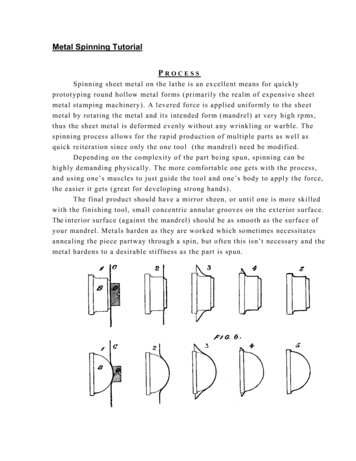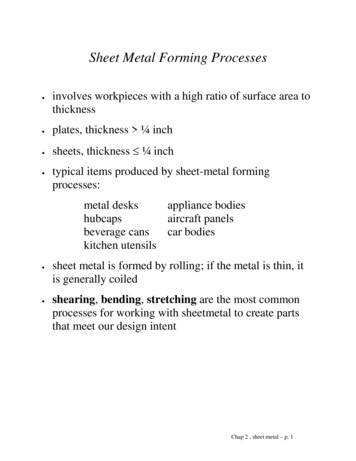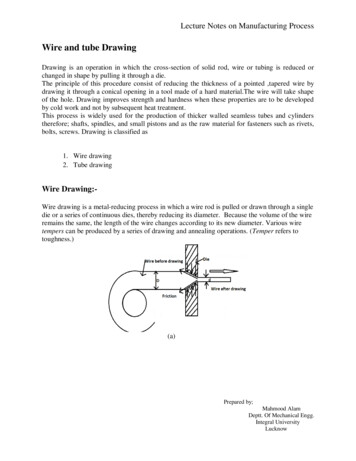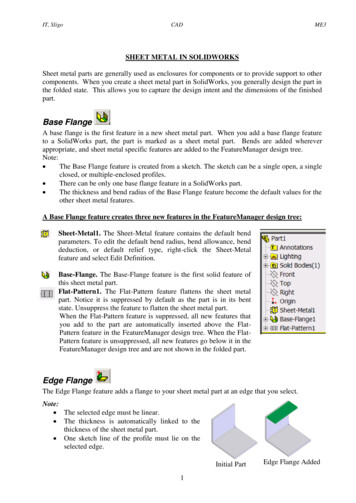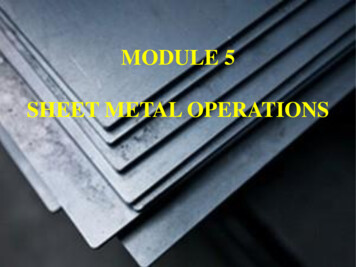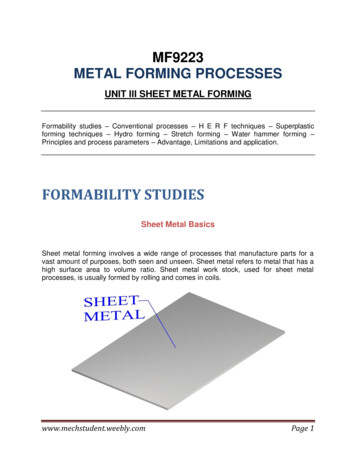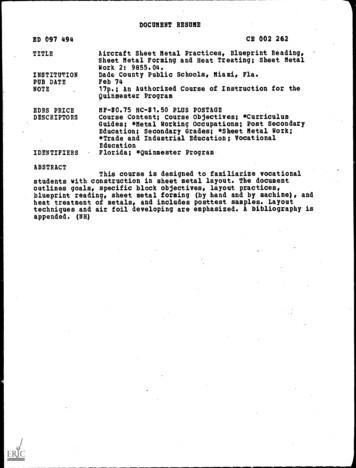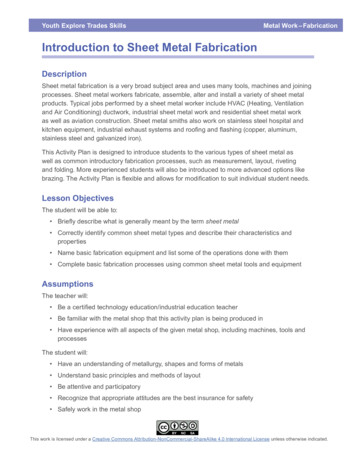
Transcription
Youth Explore Trades SkillsMetal Work – FabricationIntroduction to Sheet Metal FabricationDescriptionSheet metal fabrication is a very broad subject area and uses many tools, machines and joiningprocesses. Sheet metal workers fabricate, assemble, alter and install a variety of sheet metalproducts. Typical jobs performed by a sheet metal worker include HVAC (Heating, Ventilationand Air Conditioning) ductwork, industrial sheet metal work and residential sheet metal workas well as aviation construction. Sheet metal smiths also work on stainless steel hospital andkitchen equipment, industrial exhaust systems and roofing and flashing (copper, aluminum,stainless steel and galvanized iron).This Activity Plan is designed to introduce students to the various types of sheet metal aswell as common introductory fabrication processes, such as measurement, layout, rivetingand folding. More experienced students will also be introduced to more advanced options likebrazing. The Activity Plan is flexible and allows for modification to suit individual student needs.Lesson ObjectivesThe student will be able to: Briefly describe what is generally meant by the term sheet metal Correctly identify common sheet metal types and describe their characteristics andproperties Name basic fabrication equipment and list some of the operations done with them Complete basic fabrication processes using common sheet metal tools and equipmentAssumptionsThe teacher will: Be a certified technology education/industrial education teacher Be familiar with the metal shop that this activity plan is being produced in Have experience with all aspects of the given metal shop, including machines, tools andprocessesThe student will: Have an understanding of metallurgy, shapes and forms of metals Understand basic principles and methods of layout Be attentive and participatory Recognize that appropriate attitudes are the best insurance for safety Safely work in the metal shopThis work is licensed under a Creative Commons Attribution-NonCommercial-ShareAlike 4.0 International License unless otherwise indicated.
Introduction to Sheet Metal FabricationMetal Work – FabricationTerminologyAluminum: a metallic element that is used as an alloying agent for a group of alloys.Aviation snips: a hand tool designed to cut sheet metal into intricate designs. Can be used tocut compound curves. Red left cutting; Green right cutting; Yellow universal, able to cut inany direction.Bar folder: a sheet metal machine that is used to create straight bends in sheet metal.Bead roller: a hand roller designed to add raised, curved decorative hems to sheet metal.Beverly shear: a small hand-operated piece of equipment that has two blades that when passedagainst each other shear the metal.Box and pan brake: a sheet metal machine that is used to create bends, hems and boxes insheet metal.Brass: an alloy metal consisting of a mixture of copper and zinc. Gold/yellow in colour.Brazing: a process in which two metals are joined using a non-ferrous filler rod that is melted attemperatures over 450 C (840 F).Centre punch: a tapered piece of metal that is used to create an indent in metal to centre thedrill bit while drilling.Cold rolled steel: steel that has been rolled into its finished shape after it has been cooled. Afterthis process is complete it is put through a pickling solution or dilute acid to remove the iron oxidecoating.Combination roller: a machine used to perform burring, crimping, wire edging and other formingtechniques on sheet metal.Copper: a metallic element, orange in colour. Commonly used in art metal, electrical work and asan alloying agent.Emery cloth: an abrasive cloth used to remove material and smooth surfaces.English wheel: a hand-operated tool that enables the formation of compound curves from flatsheets of metal.Expanded sheet metal: sheets made by cutting slits into regular metal sheets and stretchingthem out to create numerous openings in a diamond pattern. Expanded sheets are lighter,stronger and less expensive than regular flat sheets. They also allow for the free passing ofliquids, light and sound.Ferrous: a metal containing high levels of iron.File: a hand tool designed to shape and smooth metal. Available in a variety of shapes and sizesto fit different projects. Made of hardened steel with varying textures to remove large or veryminimal amounts of material.Galvanized steel: a steel sheet that is dipped in a zinc coating to protect it.Gauge: the thickness of the sheet metal measured with a thickness gauge.2Youth Explore Trades Skills
Metal Work – FabricationIntroduction to Sheet Metal FabricationHammer: a tool designed to give a heavy blow to an object. Made with a variety of different headmaterials for specific purposes.Hem: a border made by folding over the edge of a piece of sheet metal to increase strength,prevent exposure of a sharp edge and increase the product’s durability.Hot rolled steel: steel that is formed into its finished shape while red hot. It is identified by itsblack oxide coating that is formed during the rolling process.Letter and number stamps: hardened steel bars with letters and numbers. Used to permanentlylabel metal projects.Non-ferrous: metals that contain little to no iron.Oxyacetylene welding: welding torches that use a combination of oxygen and acetylene toproduce a flame hot enough to join metal together using a filler metal.Rivet: a non-threaded fastener used to join metal pieces together that do not need to come apart.Roper Whitney punch: a hand tool used to punch holes in sheet metal stock.Ruler: a precision measurement tool that is a length of steel with marks at regular intervals.Scribe: a long, pointed piece of hardened steel that is used to mark layout lines on metal.Sheet metal: a term used to describe a variety of thin rolled metal sheet stock.Slip roller: hand-driven equipment that contains three hardened steel rollers: a drive roller, agripping roller and a radius roller.Spot welder: a resistance welding technique.Squaring foot shear: a foot-controlled machine used to cut sheet metal stock.Stainless steel: an alloyed steel designed to have greatly increased corrosion resistancecompared to carbon/alloy steel. Common alloying ingredients include chromium (usually at least11%), nickel and molybdenum.Tin snips: a hand tool designed to cut out layouts on sheet metal. Also called hand shears.Welding: the process by which two or more metals are joined together by heating the metals tothe point where they fuse together.Estimated Time1–2 hoursRecommended Number of Students20, based on the BC Technology Education Association Best Practices GuideFacilitiesMetal shop facility with all necessary tools, materials and equipmentYouth Explore Trades Skills3
Introduction to Sheet Metal FabricationMetal Work – FabricationTools and EquipmentPersonal protective equipmentHand Tools Aviation snips Centre punch Emery cloth Coarse and smooth files Gauge Peening hammer Letter/number stamps Rivets & rivet gun Roper Whitney punch Ruler Scribe Tin snipsStationary Equipment Bar folder Bead roller Beverley shear Box and pan brake Combination roller English wheel Oxyacetylene welder Slip roller Spot welder Squaring foot shearMaterialsMultiple samples of the various sheet metals you plan to introduce during the course foridentification and demonstration purposes. This may include aluminum, copper, brass,galvanized sheet metal, cold rolled steel, aluminum and hot rolled steel. It is suggested thatteachers demonstrate the procedures using materials that will be found in their individual shopas well as equipment that is specific to their shop.4Youth Explore Trades Skills
Metal Work – FabricationIntroduction to Sheet Metal FabricationResourcesBox and pan brakehttp://www.bing.com/videos/search?q how to use a box and pan brake&view detail&mid 0B5F895025F7C74515AE0B5F895025F7C74515AE&FORM VIRERoper Whitney punchhttp://www.bing.com/videos/search?q how to use a whiney punch&&view detail&mid 94426538A09825CF06DD94426538A09825CF06DD&FORM VRDGARBeverly shearhttp://www.bing.com/videos/search?q how to use a beverly shear&&view detail&mid EE2EE6F39C76DEA3A5DAEE2EE6F39C76DEA3A5DA&rvsmid 074FB5E6FA3B3931B7F7074FB5E6FA3B3931B7F7&fsscr 0&FORM VDMCNRBar folderhttp://www.bing.com/videos/search?q how to use a bar folder&&view detail&mid 300C3F9B87B7F4360FE7300C3F9B87B7F4360FE7&FORM VRDGAREnglish wheelhttps://www.youtube.com/watch?v omRlIBONJAM“HEADS UP! for Safety” dsup.pdfBC Technology Education Association Best Practices rn Metalworking, textbook by John R. Walker, copyright 2004, Goodheart-WilcoxCompany Inc.Youth Explore Trades Skills5
Introduction to Sheet Metal FabricationMetal Work – FabricationTeacher-led Activity 1:Introduction to Sheet Metal1. Begin by gathering all tools, materials and equipment.2. Introduce each type of sheet metal and give a brief description of each individual type,common uses and identifying characteristics. (See Material Identification & StockIdentification Activity Plans for more detailed information.)3. Distribute the attached sheet metal identification/description information sheet.4. Demonstrate how to check thickness of sheet metal stock using the thickness gauge.5. Provide sample pieces for students to handle and become familiar with.Student Activity1. Set up stations with sample pieces of sheet metal.2. Have students identify and describe each sample, using the attached sheet metalidentification worksheet.3. Provide magnets for students to test for magnetic properties of the samples.4. Students will also need a thickness gauge to correctly test for material gauges.6Youth Explore Trades Skills
Metal Work – FabricationIntroduction to Sheet Metal FabricationTeacher-led Activity 2:Introduction to Fabrication Processes1. Set up a workstation with all hand tools commonly used in the metal shop.2. Work through each hand tool, describing its name, use and any other specialty instructions.(See Introduction to Tools and Equipment Activity Plan and subsequent PowerPointpresentations for more detailed information.)3. Once hand tools are complete, move the student group to each of the stationary piecesof equipment located in the metal shop. At each describe the tool name and use anddemonstrate safe working practices.4. When all tools and equipment have been appropriately and safely demonstrated, studentscan begin the individual hands-on portion of the activity.Student Activity1. Set up workstations that include one or two of the hand tools commonly used in the metalshop (e.g., Roper Whitney punch along with rivets and a rivet gun).2. Have students work through each station, completing the task of using the equipment on asample piece of sheet metal.3. Workstations should also include the stationary equipment such as squaring foot shear, boxand pan break and spot welder.4. Once students have completed each activity they should have a variety of sample pieces ofsheet metal that have been cut, formed or joined in some way.5. The attached student station worksheet will act as a guide to ensure students work througheach station. More experienced students or peer tutors could be used to sign off on eachstudent as they complete a station.Additional stations could include combination roller, English wheel, bead roller or brazing.These additional stations may require larger sample pieces of material to ensure safe workingpractices.Note: Both activity worksheets are general in nature and are designed to provide a guide for thestudent activities. They can be added to or subtracted from to suit individual teacher and shopclassroom environments.Youth Explore Trades Skills7
Introduction to Sheet Metal FabricationMetal Work – FabricationAssessmentConsider co-creating the evaluation criteria with your students at the beginning of the activity/project. You may want to include the following: Safe working procedures at all times Personal and project management: good use of time, attitude, effort Accurate measurements and layout Appropriate use of tools All burrs and sharp edges are smooth Instructions were followed throughout the activity Correct identification of materials Description of materials is complete and includes characteristics and properties8Youth Explore Trades Skills
Metal Work – FabricationIntroduction to Sheet Metal FabricationSheet Metal Identification WorksheetNameDateSamplenumberName scribe the sample(colour, texture, etc.)#1#2#3#4#5#6#7Youth Explore Trades Skills9
Introduction to Sheet Metal FabricationMetal Work – FabricationSheet Metal Fabrication Introduction ActivityNameDateMaterial: 6" 6" sheet metalStation 1: Using the materials and equipment provided, measure, lay out and scribe lines thatdivide your metal into nine 2" 2" even squares.Station 2: Squaring foot shear: Cut your material into three long strips. They should be2" wide 6" long.Station 3: Tin snips and files: Using the snips, cut two of your long strips into six 2" squares.Using the files, file all edges on each square to remove all burrs and sharp edges.Station 4: Beverly shear: Cut your last long strip into one piece that is 2" 2" and a secondpiece that measures 2" 4".Station 5: Letter/number stamps and hammer: On each square stamp your initials and anumber from 1 through 8.Station 6: Centre punch, Roper Whitney punch and riveting: Centre punch two holes on each oftwo of your samples, for a total of four holes. Then use the Roper Whitney to punchout all four holes. Once that is complete, use the rivets and riveting gun to join yoursample pieces together, aligning all the holes.Station 7: Spot welder: Be sure to use ALL safety gear. Select two different samples ofmaterial and join them together using the spot welder. Be creative.Station 8: Bar folder or box and pan brake: Fold the 2" 4" sample piece to a 90 angle on thescribed line. Your finished product should be an L shape.Station 9: Aviation snips and files: Use the snips to cut, round or create slightly curved cornerson one of your sample pieces. Smooth any burrs or sharp edges on the cornersusing the file.Station 10: Emery cloth and peening hammer: Use the hammer to texture one of your samplesto create a dimpled pattern. Use the emery cloth to add patterns and texture as wellas smooth the surface.Station 11: Bar folder: Fold a single hem on one of the sample pieces you have not previouslyworked on.Station 12: Roper Whitney punch: Punch a hole in one corner of each of your samples. Join yoursamples together using the string/wire/key ring provided and hand in to your teacher.Make sure you have completed all station tasks.10Youth Explore Trades Skills
Metal Work – FabricationIntroduction to Sheet Metal FabricationSheet Metal Identification:Characteristics and PropertiesSheet metalnameAluminumCharacteristics and propertiesSample imageA cold-rolled non-ferrous material over0.2 mm thick but not exceeding 6 mm.A silver-coloured, low-density metalwith a huge variety of commercialapplications. Unalloyed aluminum isductile, exhibits moderate strength andis very resistant to corrosion under mostcircumstances.Aluminum can be dramaticallystrengthened by the addition ofappropriate alloying elements (Cu, Mg,Mn, Si, etc.) and subsequent heat/worktreatments. The low density of aluminummakes it a perfect material for aerospaceand in other transportation fields.BrassBrass is an alloy of copper and zinc.Brass has low friction properties andacoustic properties.Applications include decorativeand architectural uses, condenser/heat exchangers, plumbing, musicalinstruments, and fasteners. Non-ferrous.Cold rolled steelRolling steel at ambient temperature (orbelow its recrystallization temperature)increases its strength and hardness anddecreases its ductility. In addition toimprovement of mechanical properties,cold rolling results in more control overthe shape and dimensions of the finishedproduct.Cold rolled steel has an improvedsurface finish, which makes it common inthe creation of furniture, appliances andother consumer goods. Ferrous.Youth Explore Trades Skills11
Introduction to Sheet Metal FabricationSheet metalnameCopperCharacteristics and propertiesMetal Work – FabricationSample imageExcellent corrosion resistance andhigh thermal conductivity. Applicationsinclude architectural uses, coinage,condenser/heat exchangers, plumbing,radiator cores, musical instruments,locks, fasteners, hinges. Non-ferrous.Small amounts of alloying elements areoften added to copper to improve certaincharacteristics.Expanded sheetmetalSheets are made by cutting slits intoregular metal sheets and stretching themout to create numerous openings in adiamond pattern.Expanded sheets are lighter, strongerand less expensive than regular flatsheets. They also allow for the freepassing of liquids, light and sound.Ferrous.GalvanizedsteelHot-dip galvanizing is the process ofcoating iron or steel with a thin zinclayer, by passing the steel through amolten bath of zinc at a temperature ofaround 460 C (860 F). When exposedto the atmosphere, pure zinc reactswith oxygen to form zinc oxide, whichfurther reacts with carbon dioxide to formzinc carbonate, a dull grey, fairly strongmaterial that stops further corrosion inmany circumstances, protecting the steelbelow from the elements.Galvanized steel is widely used inapplications where rust resistance isneeded, and can be identified by thecrystallization patterning on the surface(often called a spangle).Ferrous.Technically, galvanized steel canbe welded, but extreme caution isneeded, as the resulting zinc fumesare lethal if inhaled.12Youth Explore Trades Skills
Metal Work – FabricationSheet metalnameCharacteristics and propertiesHot rolled steelHot rolling involves the production ofsheet metal from billets by passing thesteel through rollers while above itsrecrystallization temperature (over 926 C/ 1700 F). Multiple passes through therollers may be necessary to produce thefinal desired dimensions. It is identifiedby the black oxide coating that is formedduring the rolling process. FerrousStainless steelAn alloyed steel designed to havegreatly increased corrosion resistancecompared to carbon/alloy steel. Commonalloying ingredients include chromium(usually at least 11%), nickel andmolybdenum. Ferrous.Youth Explore Trades SkillsIntroduction to Sheet Metal FabricationSample image13
Introduction to Sheet Metal Fabrication Meta lWork – Fabrci ation 2 Youth Explore Trades Skills Terminology Aluminum: a metallic element that is used as an alloying agent for a group of alloys. Aviation snips: a hand tool designed to cut sheet metal into intricate designs.Can be used to cut compound curves. Red left cutting;

